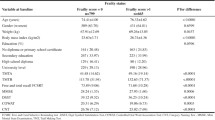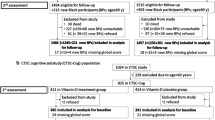Abstract
Introduction: Concerns about the effects of HMG-CoA reductase inhibitors (‘statins’) on health-related quality of life may contribute to their underuse in older adults with and at risk for cardiovascular disease. These concerns also may prevent clinicians from enrolling older patients in clinical trials assessing the efficacy of statins as a preventive therapy for Alzheimer’s disease.
Objective: To determine the effects of pravastatin and tocopherol (vitamin E), alone and in combination, on health-related quality of life in older adults.
Study design: Double-blind, randomised, placebo-controlled, crossover study.
Participants: Forty-one community-dwelling men and women aged ≥70 years with low-density lipoprotein-cholesterol (LDL-C) ≥3.62 mmol/L (140 mg/dl) participated.
Methods: Subjects received pravastatin for 6 months then pravastatin plus tocopherol for an additional 6 months (group 1), or tocopherol for 6 months then pravastatin plus tocopherol for an additional 6 months (group 2). Dosages were pravastatin 20mg daily and tocopherol 400IU daily.
Main outcome measures: The following health-related quality-of-life measures were assessed at baseline, after 6 months and after 1 year: health perception, depression, physical function, cognitive function and sleep behaviour. In addition, data on adverse effects and laboratory abnormalities were obtained.
Results: Pravastatin reduced levels of total cholesterol (−21%, p < 0.001) and LDL-C (−29%, p < 0.001). Health-related quality-of-life scores, physical adverse effects, muscle enzyme levels and liver function tests did not change after 12 months of therapy with pravastatin, tocopherol or their combination.
Conclusion: Both pravastatin and tocopherol have a good safety profile, are well tolerated and do not adversely affect health-related quality of life in older patients with hypercholesterolaemia. Given the significant beneficial cardiovascular effects of statin therapy in older adults and the potential role of statins in prevention of Alzheimer’s disease, concerns about adverse effects on quality of life should not deter use of these medications in this population.





Similar content being viewed by others
References
Corti MC, Guralnik JM, Salive ME, et al. Clarifying the direct relation between total cholesterol levels and death from coronary heart disease in older persons. Ann Intern Med 1997; 126: 753–60
Rubin SM, Sidney S, Black DM, et al. High blood cholesterol in elderly men and the excess risk for coronary heart disease. Ann Intern Med 1990; 113: 916–20
Kivipelto M, Helkala EL, Laakso MP, et al. Midlife vascular risk factors and Alzheimer’s disease in later life: longitudinal, population based study. BMJ 2001; 322: 1447–51
Notkola IL, Sulkava R, Pekkanen J, et al. Serum total cholesterol, apolipoprotein E epsilon 4 allele, and Alzheimer’s disease. Neuroepidemiology 1998; 17: 14–20
Jarvik GP, Wijsman EM, Kukull WA, et al. Interactions of apolipoprotein E genotype, total cholesterol level, age and sex in prediction of Alzheimer’s disease: a case-control study. Neurology 1995; 45: 1092–6
Rubin SM, Sidney S, Black DM, et al. High blood cholesterol in elderly men and the excess risk for coronary heart disease. Ann Intern Med 1990; 113: 916–20
Scandinavian Simvastatin Survival Study Group. Randomised trial of cholesterol lowering in 4444 patients with coronary heart disease: The Scandinavian Simvastatin Survival Study (4S). Lancet 1994; 344: 1383–9
Sacks FM, Pfeffer MA, Moye LA, et al. The effect of pravastatin on coronary events after myocardial infarction in patients with average cholesterol levels. N Engl J Med 1996; 335: 1001–9
Miettinen TA, Pyörälä K, Olsson AG, et al. Cholesterol-lowering therapy in women and elderly patients with myocardial infarction or angina pectoris: findings from the Scandinavian Simvastatin Survival Study (4S). Circulation 1997; 96: 4211–8
Lewis SJ, Moye LA, Sacks FM, et al. Effect of pravastatin on cardiovascular events in older patients with myocardial infarction and cholesterol levels in the average range. Ann Intern Med 1998; 129: 681–9
Hunt D, Young P, Simes J, et al. Benefits of pravastatin on cardiovascular events and mortality in older patients with coronary heart disease are equal to or exceed those seen in younger patients: results from the LIPID Trial. Ann Intern Med 2001; 134: 931–40
Carlsson CM, Carnes M, McBride PE, et al. Managing dyslipi-demias in older adults. J Am Geriatr Soc 1999; 47: 1458–65
Heart Protection Study Collaborative Group. MRC/BHF Heart Protection Study of cholesterol lowering with simvastatin in 20 536 high-risk individuals: a randomised placebo-controlled trial. Lancet 2002; 360: 7–22
Jick H, Zornberg GL, Jick SS, et al. Statins and the risk of dementia. Lancet 2000; 356: 1627–31
Wolozin B, Kellman W, Ruosseau P, et al. Decreased prevalence of Alzheimer disease associated with 3-hydroxy-3-methyglutaryl coenzyme A reductase inhibitors. Arch Neurol 2000; 57: 1439–43
McBride P, Schrott HG, Plane MB, et al. Primary care practice adherence to National Cholesterol Education Program guidelines for patients with coronary heart disease. Arch Intern Med 1998; 158: 1238–44
Aronow WS. Underutilization of lipid-lowering drugs in older persons with prior myocardial infarction and a serum low-density lipoprotein cholesterol >125 mg/dl. Am J Cardiol 1998; 82: 668–9
Mendelson G, Aronow WS. Underutilization of measurement of serum low-density lipoprotein cholesterol levels and of lipid-lowering therapy in older patients with manifest atherosclerotic disease. J Am Geriatr Soc 1998; 46: 1128–31
Majumdar SR, Gurwitz JH, Soumerai SB. Undertreatment of hyperlipidemia in the secondary prevention of coronary artery disease. J Gen Intern Med 1999; 14: 711–7
Pearson TA, Laurora I, Chu H, et al. The lipid treatment assessment project (L-TAP): a multicenter survey to evaluate the percentages of dyslipidemic patients receiving lipid-lowering therapy and achieving low-density lipoprotein cholesterol goals. Arch Intern Med 2000; 160: 459–67
Fonarow GC, French WJ, Parsons LS, et al. Use of lipid-low-ering medications at discharge in patients with acute myocardial infarction: data from the National Registry of Myocardial Infarction 3. Circulation 2001; 103: 38–44
Santinga JT, Rosman HS, Rubenfire M, et al. Efficacy and safety of pravastatin in the long-term treatment of elderly patients with hypercholesterolemia. Am J Med 1994; 96: 509–15
Chan P, Lee C, Lin TS, et al. The effectiveness and safety of low dose pravastatin in elderly hypertensive hypercholester-olemic subjects on antihypertensive therapy. Am J Hypertens 1995; 8: 1099–104
Black DM, Bakker-Arkema RG, Nawrocki JW. An overview of the clinical safety profile of atorvastatin (Lipitor), a new HMG-CoA reductase inhibitor. Arch Intern Med 1998; 158: 577–84
Santanello NC, Barber BL, Applegate WB, et al., for the CRISP Collaborative Study Group. Effect of pharmacologic lipid lowering on health-related quality of life in older persons: results from the Cholesterol Reduction in Seniors Program (CRISP) Pilot Study. J Am Geriatr Soc 1997; 45: 8–14
Swan GE, LaRue A, Carmelli D, et al. Decline in cognitive performance in aging twins: Heritability and biobehavioral predictors from the National Heart, Lung and Blood Institute Twin Study. Arch Neurol 1992; 49: 476–81
Benton D. Do low cholesterol levels slow mental processing? Psychosom Med 1995; 57: 50–3
Cattin L, Bordin P, Fonda M, et al. Factors associated with cognitive impairment among older Italian inpatients. Gruppo Italiano di Farmacovigilanza nell’Anziano (G.I.F.A.). J Am Geriatr Soc 1997; 45: 1324–30
Morgan RE, Palinkas LA, Barrett-Connor EL, et al. Plasma cholesterol and depressive symptoms in older men. Lancet 1993; 341: 75–9
Olusi SO, Fido AA. Serum lipid concentrations in patients with major depressive disorder. Biol Psychiatry 1996; 40: 1128–31
Muldoon MF, Ryan CM, Matthews KA, et al. Serum cholesterol and intellectual performance. Psychosom Med 1997; 59: 382–7
Muldoon MF, Barger SD, Ryan CM, et al. Effects of lovastatin on cognitive function and psychological well-being. Am J Med 2000; 108: 538–46
Vgontzas AN, Kales A, Bixler EO, et al. Effects of lovastatin and pravastatin on sleep efficiency and sleep stages. Clin Pharmacol Ther 1991; 50: 730–7
Rosenson RS, Goranson NL. Lovastatin-associated sleep and mood disturbances. Am J Med 1993; 95: 548–9
Roth T, Richardson GR, Sullivan JP, et al. Comparative effects of pravastatin and lovastatin on nighttime sleep and daytime performance. Clin Cardiol 1992; 15: 426–32
Lyle BJ, Mares-Perlman JA, Klein BEK, et al. Supplement users differ from nonusers in demographic, lifestyle, dietary and health characteristics. J Nutr 1998; 128: 2355–62
Vitolins MZ, Quandt SA, Case LD, et al. Vitamin and mineral supplement use by older rural adults. J Gerontol A Biol Sci Med Sci 2000; 55: M613–7
Yusuf S, Dagenais G, Pogue J, et al. Vitamin E supplementation and cardiovascular events in high-risk patients. The Heart Outcomes Prevention Evaluation Study Investigators. N Engl J Med 2000; 342(3): 154–60
Kappus H, Diplock AT. Tolerance and safety of vitamin E: a toxicological position report. Free Radic Biol Med 1992; 13: 55–74
Keith ME, Jeejeebhoy KN, Langer A, et al. A controlled clinical trial of vitamin E supplementation in patients with congestive heart failure. Am J Clin Nutr 2001; 73(2): 219–24
Sano M, Ernesto C, Thomas RG, et al. A controlled trial of selegiline, alpha-tocopherol, or both as treatment for Alzheimer’s disease. The Alzheimer’s Disease Cooperative Study. N Engl J Med 1997; 336(17): 1216–22
Age-Related Eye Disease Study Research Group. A randomized, placebo-controlled, clinical trial of high-dose supplementation with vitamins C and E, beta carotene, and zinc for age-related macular degeneration and vision loss: AREDS report no. 8. Arch Ophthalmol 2001; 119(10): 1417–36
Stein JH, Carlsson CM, Papcke-Benson K, et al. The effects of lipid-lowering and antioxidant vitamin therapies on flow-mediated vasodilation of the brachial artery in older adults with hypercholesterolemia. J Am Coll Cardiol 2001; 38: 1806–13
Friedewald WT, Levy RI, Fredrickson DS. Estimation of the concentration of low-density lipoprotein cholesterol in plasma, without use of the preparative ultracentrifuge. Clin Chem 1972; 18: 499–502
Andrews FM, Withey SB. Developing measures of perceived life quality: results from several national surveys. Social Indicators Research 1974; 1: 1–26
Yesavage JA, Brink TL, Rose TL, et al. Development and validation of a geriatric depression screening scale: a preliminary report. J Psychiatr Res 1983; 17: 37–49
Williams JH, Drinka TJ, Greenberg JR, et al. Development and testing of the assessment of living skills and resources (AL-SAR) in elderly community-dwelling veterans. Gerontologist 1991; 31: 84–91
Wechsler D. Manual for the Wechsler Adult Intelligence Scale (WAIS-R). New York: Psychological Corp, 1955
Rose RM, Jenkins CD, Hurst MW. Air traffic controller health change study: report to Federal Aviation Administration. Boston (MA): Boston University School of Medicine, Document FAA-AM-78-39, August 1978
Efron B. Bootstrap methods: another look at the jackknife. Annals of Statistics 1983; 7: 1–26
Wei LJ, Johnson WE. Combining dependent tests with incomplete repeated measurements. Biometrika 1985; 72: 359–64
Davis CS. Semi-parametric and non-parametric methods for the analysis of repeated measurements with applications to clinical trials. Stat Med 1991; 10: 1959–80
American Heart Association 2002. Heart and stroke statistical update. Dallas (TX): American Heart Association, 2001
Lenth RV. Some practical guidelines for effective sample size determination. Am Stat 2001; 55: 187–93
Wechsler D. WAIS-R manual: Wechsler Adult Intelligence Scale-Revised. New York(NY): The Psychological Corp, 1981
Jenkins CD, Stanton BA, Niemcryk SJ, et al. A scale for the estimation of sleep problems in clinical research. J Clin Epidemiol 1988; 41: 313–21
Acknowledgements
This study was funded by the University of Wisconsin Medical School and Bristol-Myers Squibb, Inc. Dr Stein conducts research and is a consultant for Bristol-Myers Squibb.
Author information
Authors and Affiliations
Rights and permissions
About this article
Cite this article
Carlsson, C.M., Papcke-Benson, K., Carnes, M. et al. Health-Related Quality of Life and Long-Term Therapy with Pravastatin and Tocopherol (Vitamin E) in Older Adults. Drugs Aging 19, 793–805 (2002). https://doi.org/10.2165/00002512-200219100-00008
Published:
Issue Date:
DOI: https://doi.org/10.2165/00002512-200219100-00008




